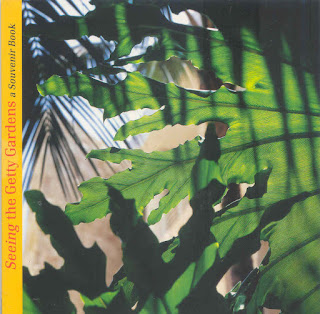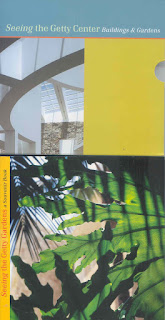
 Seeing the Getty Center Buildings & Gardens are two little booklets published by Getty Publishing House as souvenir books.
Seeing the Getty Center Buildings & Gardens are two little booklets published by Getty Publishing House as souvenir books.These booklets explain the philosophy of the Getty Center and its expansion.
At first the Getty was a little museum wanted so badly by philanthropist J. Paul Getty.
There were just three collections of old antiquities in the first museum, while later after the transformation the Getty became a beautiful environment of serenity, harmony with the surrounding city of Los Angeles.
In the project, before the construction started, were involved scholars, scientists and educators for trying to understand the "how to do this."
The Getty wanted to become the center for international research in visual arts and humanities in a fusion between architecture, environment, art, nature, speaking all the same harmonic language of beauty and posterity.
At first the Getty Trust bought 700 acres of land in the Santa Monica mountains.
Richard Meier, the architect created and thought at a space of inclusion where the main structure harmonically set like a gem in the surrounding area made by courtyards, gardens, terraces.
This land preserved intact in its magnificence and beauty.
The Getty was created in 14 years.
Modern forms, it is structured in this way: J.Paul Getty Museums, the Getty Research Institute of Art and Humanities, the Getty Conservation Institute, the Getty Information Institute, the Getty Information Institute for the Arts, the Getty Grant Program, and last the Getty Trust's administration offices.
There is a restaurant and a café and an auditorium with 450 seats.
The Getty gives hospitality at lectures, films, concerts, and many other events and it's one of the main choices for families in search for some peace, when, in particular they want to spend relaxing time a bit distant from a crowded city like Los Angeles is.
More than 16.000 tons of travertine from Bagni di Tivoli a locality close to Rome, Italia, chosen for created stunning facades but also pavements.
The beauty of the Getty looking also at the pics of these booklets is this: you don't miss air.
You can breath. It's like to enter in an immense peaceful place where you can feel the soul fresher and restored by the sometimes small problems of the daily routine.
There are no claustrophobic places, there is air, a lightness that will enter in the heart of visitors of the Getty Center.
You have the impressions, looking at the pics in these booklets that you leave in the city all the problems and you are invigorated by a visit at the Getty.
And now the gardens of the Getty: I just hope to return to the topic with other books, but in the while I can tell you that the gardens of the Getty are the pride of this structure.
Harmony, beauty, art, color what it was searched and researched by the creatives inside the gardens of the Getty was this.
Many oak trees, but also fruit trees, abundantly, and plazas, fountains, now a paradise for birds, butterflies and other animals.
In the Getty it's possible to admire the change of seasons.
Many plants adapted at warm seasons (I love to compare California at our South Italy) like cactus with its diversified shapes. You can also find aloe, and many culinary herbs, let's mention rosemary planted in the Getty Gardens. In the rock garden as I love to call the Central Garden, typical flowers from South Dakota.
These booklets are a joy for the eyes.
The concept of museum is lived not anymore as a space in grade to restore a stressed spirit passing just through statues, and painting that the visitors will see and that surely will help him/her spiritually but in a symbiotic condition with the environment created for enlightening and elevate the spirit: spaces in grade to offer spiritual answers also thanks to a land very friendly and close to the human being.
I thank Getty Publishing for these booklets.
Anna Maria Polidori
No comments:
Post a Comment